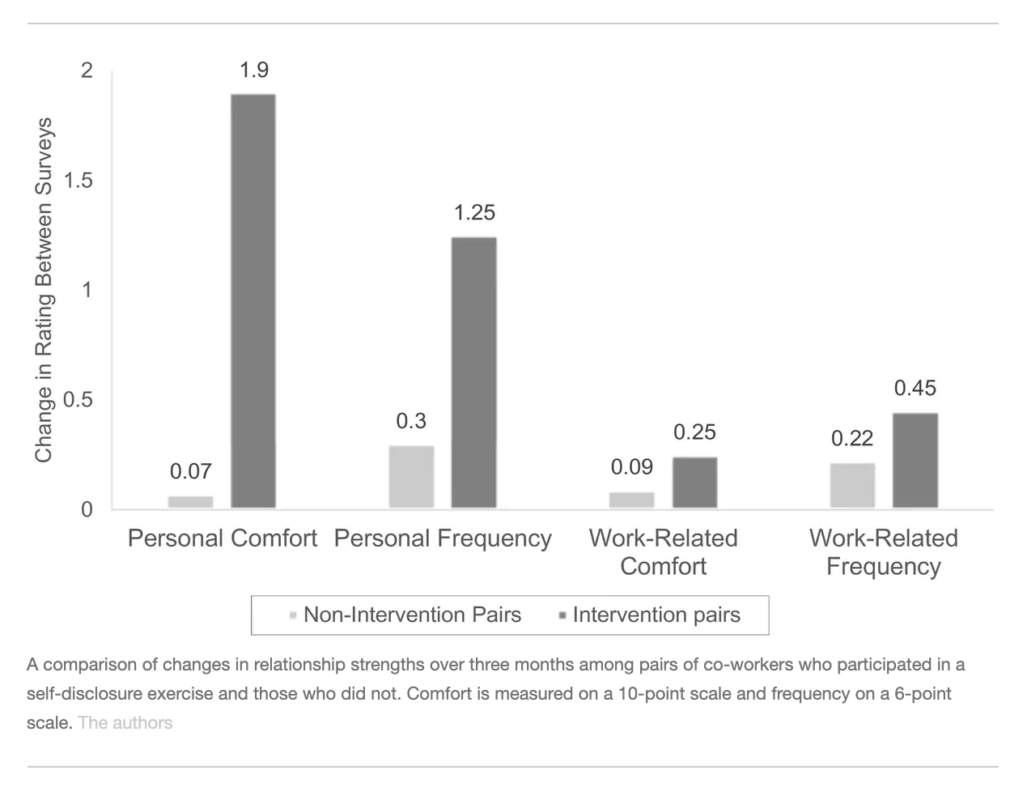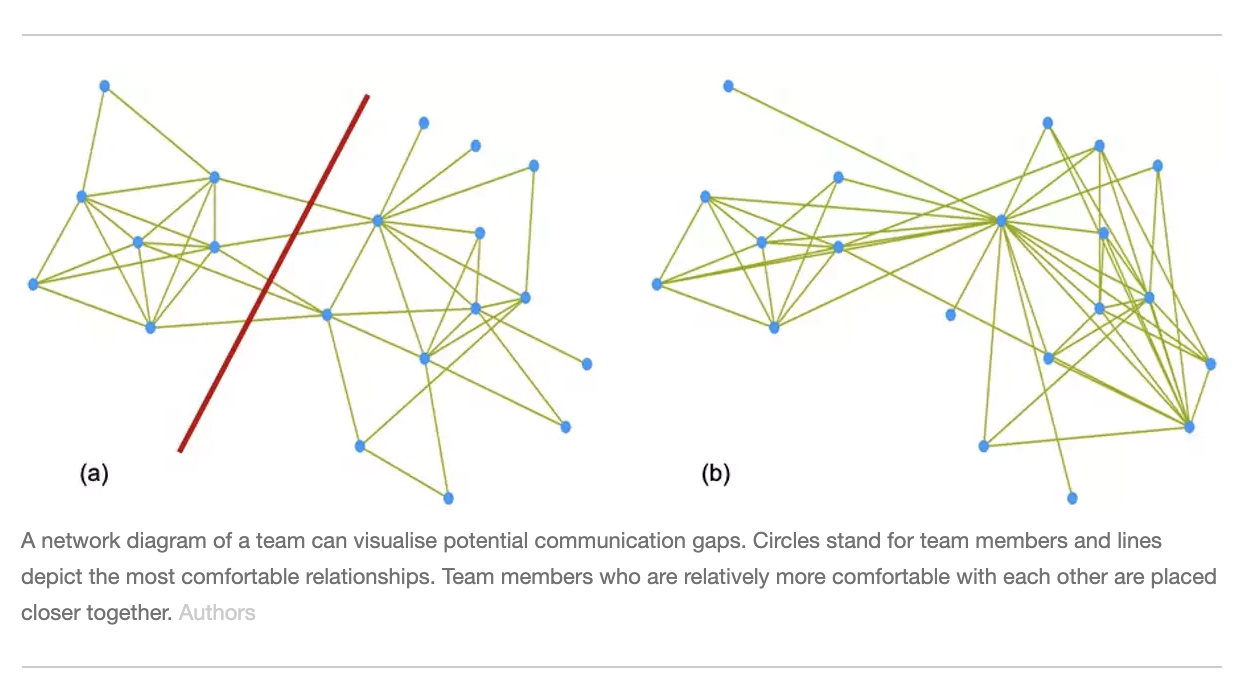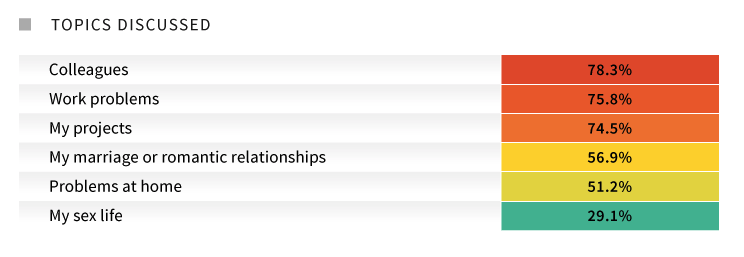While leaders might feel the urge to run company-wide team building exercises to foster employee bonding, research suggests it’s better to encourage a close connection between two people.
Setting appropriate boundaries at work can be difficult. Staff are encouraged to “bring their whole selves to work” while also being cautious not to overstep professional boundaries.
But getting more personal in the name of workplace cohesion is exactly what new research from associate professor Jullien Pollack and associate dean Petr Matous of the University of Sydney suggest we should be doing. Instead of creating bonds between all employees, they say we should be focusing on the connection between pairs of individuals.
Asking questions to create a bond
In a breakdown of their research for The Conversation, Pollack and Matous say it’s important to remember that “teams are social networks built on connections between individuals”.
They refer to a viral social experiment from the late 90s that was revived by the New York Times in 2015. It was based on the idea that any two people could fall in love if they asked each other 36 specific questions.
The first round of questions are quite standard: “Would you like to be famous? If so, in what way?” And, “What would constitute a ‘perfect’ day for you?” But as the experiment goes on, the questions become more personal, such as: “Of all the people in your family, whose death would you find most disturbing? Why?”
Following the NYT article (spoiler: the author did fall in love with her partner after going through the questions, although she can’t entirely credit this to the experiment), it became common to see social media videos of strangers carrying out the same experiment, and other variants of this experiment started to become popular. But they weren’t always about forming a romantic connection.
SBS produced a series called ‘Look Me In the Eye’ based on the idea that two people could mend a severely broken relationship by remaining silent and looking at one another in the eye for a certain period of time. And it wasn’t bickering siblings they were dealing with, these people had real problems. A Sudanese child soldier coming face-to-face with his former torturer, for example.
I underwent a similar experiment myself, except the person I was paired with was a stranger. I was asked to go into a room full of people and to take a seat in front of anyone. The rules were simple: look into the other person’s eyes for as long as you can without speaking and take note of how it makes you feel. (We ended up holding eye contact for half an hour. We were one of the final couples remaining in the room. I know it wasn’t a competition or anything, but we were solid runners up for the “best starers in the room” prize).
As you’d expect, I felt a little silly at first. My stranger and I cracked a few nervous smiles, which turned into suppressed laughter, but after we’d pushed through the first five minutes, my feelings towards him shifted dramatically. It wasn’t just us. At the ten minute mark, I could see strangers hugging and holding hands in my peripheral vision and I heard some crying. There was a lot of emotional energy in the room.
No, we didn’t fall in love (although, I wish that’s how this story ended), but I did start to feel connected to him in a way that even now I can’t articulate – which is the whole idea behind this technique. You create a connection that’s unique to the two of you.
“I could see strangers hugging and holding hands in my peripheral vision and I heard some crying. There was a lot of emotional energy in the room.”
In Pollack and Matous’ version of the 36 question experiment, they were able to produce data to show how these connections look in a workplace environment.
They asked office pairs who were critical to the overall cohesion of the workplace – for example, that could be an HR lead and the CEO – to undergo the 36 question experiment and then tracked the pairs’ communication patterns over the following three months. They found that communication frequency increased amongst those pairs who answered the questions, as did their comfort level around discussing personal matters with their partner (see graph below).

They were able to demonstrate this increase in communication further, by presenting what they call a social network analysis (chart below).

They mapped the network prior to and after their ‘36 questions’ experiment. The red line in Chart A represents the divide between two teams who were brought together to work under the same manager. While there was some crossover between the two sides, the main connection points flowed between those in their previously separate teams.
Chart B represents the connections made between the group following the three months of communication tracking. The closer the blue dots are together, the closer the pair identified themselves to be. And, as you can see, close blue dots amounted to more overall connections.
Why do we have work spouses?
The researchers’ work is connected to the idea of having a ‘work wife’ or ‘work husband’. This concept might make you feel a little icky at first, but work spouses have been shown to be tremendous contributors to the health of employees and organisations.
It’s not about replacing your real wife with Karen from finance. It’s about having a person in your working environment who you can rely upon emotionally. Much like you would with your romantic partner, you may seek comfort in your work spouse or share personal details of your life. It’s an intense, purely platonic, connection that can have a positive ripple effect on the entire office.
Some US research suggests having a work spouse increases productivity and personal happiness, and experts from Beyond Blue say they also play a role in maintaining strong mental health at work.
“Studies suggest that work wife and husband relationships are particularly beneficial in fast-paced and high stress working environments. The qualities of trust and humour, which many of these relationships are built on, help manage stress and prevent burnout. Also, these relationships are catching to the rest of the office: they boost morale, encourage camaraderie and help fight toxic workplaces,” the Beyond Blue article reads.
“Your work wife or husband helps you be yourself, be happy and want to contribute, which is beneficial to achieving work/life balance.”
“Studies suggest that work wife and husband relationships are particularly beneficial in fast-paced and high stress working environments.”
Risks of having a work spouse
The first mention of ‘work spouse’ would have raised eyebrows for some. Working in HR, you’re primed to look for potential issues that could arise from staff becoming a little too close for comfort. And there are, of course, risks.
Drawing on surveys from over 1,000 US employees, SimplyHired found that 44 per cent of men and 50.2 per cent of women had a work spouse at some point. It’s most common that person works at the same level as them, although 23.7 per cent of entry level employees said their work spouse was a superior.
Nearly 74 per cent of respondents who were married or in a relationship admitted to feeling some level of attraction towards their work spouse – compared to nearly 71 per cent of single employees – and 21 per cent of respondents lied to their romantic partner about having a work spouse. “Extreme” levels of attraction were only an issue for 11.6 per cent of men and 7.5 per cent of women.
While the majority of conversations between work spouses are work related, many did admit to wading in potentially dangerous waters, such as discussing their sex lives. This trend is mirrored in activities they’d done together, with the most common being work related (helping each other with work projects and eating lunch together), but inappropriate behaviours like kissing or staying in the same hotel room were still present.

(Have you ever had a work spouse? We’d like to know more about it. Take HRM’s quick online survey.)
They make you feel safe
Even if you don’t feel you have a work spouse per se, there’s likely someone in your office that you feel closer to than others.
“In any situation, be it at a party or at work, most of us naturally tend to gravitate towards those we know. In doing so we strengthen already strong relationships. Familiarity creates psychological safety – the feeling of trust that you are free to be you,” say Pollack and Matous.
Psychological safety is critical to ensuring your workplace runs like a well-oiled machine.
In an article for the Harvard Business Review, Stanford University Instructor and international speaker Laura Delizonna, says when humans don’t have a sense of psychological safety, our brains go into meltdown.
“The amygdala, the alarm bell in the brain, ignites the fight-or-flight response, hijacking higher brain centers. This “act first, think later” brain structure shuts down perspective and analytical reasoning. Quite literally, just when we need it most, we lose our minds,” she says.
When we do feel psychologically safe, Delizonna says we’re more open-minded, persistent, resilient and motivated.
“Humor increases, as does solution-finding and divergent thinking — the cognitive process underlying creativity… When the workplace feels challenging but not threatening, teams can sustain the broaden-and-build mode. Oxytocin levels in our brains rise, eliciting trust and trust-making behavior. This is a huge factor in team success.”
Pollack and Matous say psychological safety can improve your team’s ability to be innovative.
“Building psychological safety takes time, however, and normal workplace interactions may not be conducive to developing trust naturally. Which is why managers often turn to team-building exercises,” say Pollack and Matous.
The researchers are careful to point out while their experiment suggests positive results that have the potential to benefit a whole organisation, this doesn’t mean it will work for everyone.
Some employees will feel uncomfortable disclosing any kind of personal information and that’s okay. No one should be forced to participate in an exercise like the 36 questions. But if there’s an appetite for it, this could be a great alternative to many ‘team bonding, just add water’ approaches, like a company speed dating-style exercise, which don’t always produce the desired outcomes.
The takeaway here isn’t to start staring into your desk buddy’s eyes in an effort to increase your productivity, but to reconsider how you encourage workplace social connections. If you’re worried that two people might be spending too much time together, don’t be. Their glorious workplace nuptials might just be what your office needs.
Cohesive teams produce better results, so how can you make sure yours is on the right track? Building Effective Teams, will facilitate discussions and offer practical skills for team leaders.


Many thanks once again for providing a very thought provoking article into a truly critical area in the development of truly collaborative work environments. I am somewhat perplexed though that there are those who either do not comprehend this or do not wish to comprehend. We are encouraged to work on our personal relationships, for our own well being, and the well being of our relationship with our spouse or significant other and yet we believe we can turn up at work and work alongside others, with no consideration for those relationships! As stated in the article, finding a way… Read more »
this is interesting as i never heard on this work spouse. Through this article, i know about this work spouse and this may help in increasing productivity in the company, but this kind of connection is not easy to take care, if the connection is not handle well, it may lead to disaster. I feel by having work spouse may create some work conflict as some might wanted their work spouse to share some confidential information to assist on their career. this will lead to unethical action to occur if the connection is beyond boundaries.